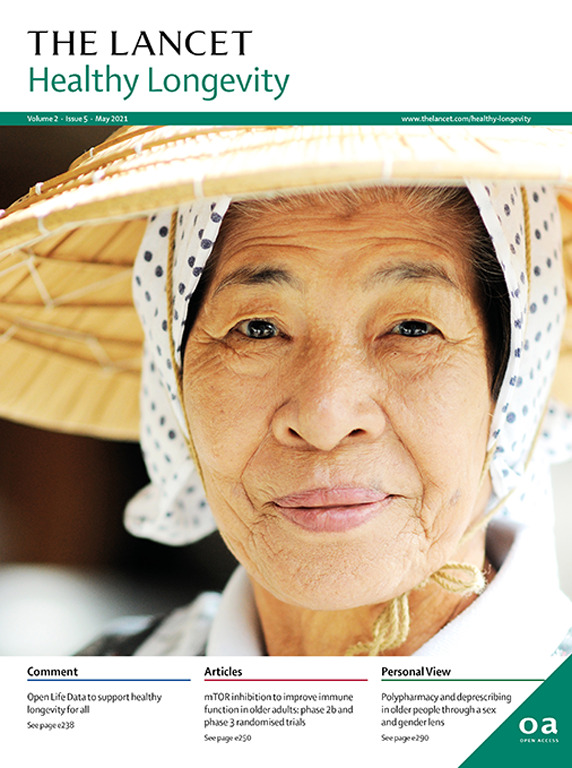英国成人急性全科医疗服务患者谵妄的发生、相关因素和结局:一项为期10年的纵向观察研究
IF 14.6
Q1 GERIATRICS & GERONTOLOGY
引用次数: 0
摘要
背景:谵妄发生和结局的可靠估计对于医院服务、研究和政策都是必要的,但长期随访的包容性队列很少。我们的目的是评估急性全科(内科)医学中谵妄的年龄特异性发生率、相关因素以及按年龄和合并症痴呆状态分层的10年结局。方法本纵向观察性研究在英国牛津约翰·拉德克利夫医院进行。我们纳入了6个为期8周(2010年9月4日至2018年11月15日)的急性普通(内科)医学服务的16岁及以上的连续成年患者。采用神志不清评估法和第四版《精神障碍诊断与统计手册》对谵妄进行前瞻性诊断,并将其分类为常见于(入院≤48小时)或偶发(入院后48小时)。根据人口统计学、合并症、虚弱和疾病严重程度计算二值化结果的调整优势比(adjORs),并根据死亡时间计算调整风险比(adjhr)。结果1846例急性普通(内科)住院患者(平均年龄68.2岁[SD 20.0],年龄16-102岁),其中426例(23% [95% CI 21-25])存在谵妄(常见病n=290[68%],发病率n=73[17%],常见病和发病率n=63[15%]),其中134例(31.5%)存在痴呆。女性950例(51.5%),男性895例(48.5%),1例患者性别资料缺失。谵妄随着年龄的增长而增加,年龄在50岁以下的340例患者中有6例(2% [95% CI 1-4]), 50 - 64岁的333例患者中有31例(9%[6-13]),65-74岁的281例患者中有57例(20%[16-25]),75-89岁的704例患者中有245例(35%[31 - 38]),90岁及以上的188例患者中有87例(46%[39-54])。在37例65岁以下的谵妄患者中,28例(76%)有潜在的神经或神经精神障碍。在65岁及以上的患者中,谵妄与痴呆(adjOR 3.63 [95% CI 2.65 - 4.98])、入院前依赖(CI 2.63[2.02 - 3.43])、共病负担(CI 1.04[1.02 - 1.05])和虚弱(中危对低危3.62[2.70 - 4.85]、高危对低危11.85[7.24 - 19.42])总体相关(p < 0.01,年龄和性别调整),且无共病痴呆患者的相关性强于共病痴呆患者。谵妄预测住院时间超过7天(adjOR 2.48[1.84 - 3·35])、出院护理需求(adjOR 2.41[1.70 - 3.40])和入院死亡率(adjOR 2.45[1.52 - 3.94])。谵妄组的死亡风险增加在入院后立即最高,此后逐渐减弱,但在长达10年的随访中保持不变(30天死亡率的adjHR为2.03 [95% CI为1.40 - 2.97],10年死亡率的adjHR为1.52 [95% CI为1.30 - 1.77])。与老年组相比,年轻组的住院死亡率最高(adjOR 4.38 [95% CI 1.18 - 16.31];65 ~ 74岁P = 0.028 vs . 1.96 [1.02 ~ 3.75];75 ~ 89岁时P = 0.043, 75 ~ 89岁时P = 2.86 [1.14 ~ 7.16];90岁及以上时p= 0.025),无痴呆伴发者与伴发痴呆伴发者(adjOR 3.02 [1.73 - 5.25];P< 0.001 vs 1.47 [0.58 - 3.75];p = 0·42)。解释:我们的研究结果支持65岁以后入院时谵妄筛查的现行指南。在65-74岁无痴呆合并症的人群中,谵妄结局相对更不利,干预和临床试验应优先考虑。资助国家健康和护理研究所和医学研究委员会。本文章由计算机程序翻译,如有差异,请以英文原文为准。
Occurrence, associated factors, and outcomes of delirium in patients in an adult acute general medicine service in England: a 10-year longitudinal, observational study
Background
Reliable estimates of delirium occurrence and outcomes are necessary to inform hospital services, research, and policy, but inclusive cohorts with long-term follow-up are scarce. We aimed to assess the age-specific occurrence of delirium in acute general (internal) medicine, associated factors, and 10-year outcomes stratified by age and comorbid dementia status.
Methods
This longitudinal, observational study was done at the John Radcliffe Hospital (Oxford, UK). We included consecutive adult patients aged 16 years and older in an acute general (internal) medicine service over six 8-week periods (between Sept 4, 2010, and Nov 15, 2018). Delirium was diagnosed prospectively using the Confusion Assessment Method and Diagnostic and Statistical Manual of Mental Disorders, fourth edition, criteria and subcategorised as prevalent (≤48 h of admission) or incident (>48 h postadmission). Odds ratios adjusted (adjORs) for demographics, comorbidity, frailty, and illness severity were calculated for binarised outcomes and adjusted hazard ratios (adjHRs) were calculated for time to death.
Findings
1846 patients were admitted to acute general (internal) medicine (mean age 68·2 years [SD 20·0], age range 16–102 years), 426 (23% [95% CI 21–25]) of whom had delirium (prevalent n=290 [68%], incident n=73 [17%], both prevalent and incident n=63 [15%]), of whom 134 (31·5%) had dementia. 950 (51·5%) patients were female, 895 (48·5%) were male, and sex data were missing for one patient. Delirium increased with age, from six (2% [95% CI 1–4]) of 340 patients younger than 50 years and 31 (9% [6–13]) of 333 patients at age 50–64 years to 57 (20% [16–25]) of 281 at age 65–74 years, 245 (35% [31–38]) of 704 at age 75–89 years, and 87 (46% [39–54]) of 188 at age 90 years and older. Of the 37 patients younger than 65 years who had delirium, 28 (76%) had an underlying neurological or neuropsychiatric disorder. In those aged 65 years or older, delirium was overall associated (all p<0·001, age and sex adjusted) with dementia (adjOR 3·63 [95% CI 2·65–4·98]), pre-admission dependency (2·63 [2·02–3·43]), comorbidity burden (1·04 [1·02–1·05]), and frailty (moderate vs low risk 3·62 [2·70–4·85] and high vs low risk 11·85 [7·24–19·42]), with stronger associations in patients without comorbid dementia than in those with comorbid dementia. Delirium predicted inpatient stay longer than 7 days (adjOR 2·48 [1·84–3·35]), discharge care needs (2·41 [1·70–3·40]), and mortality during admission (2·45 [1·52–3·94]). The increased risk of death in the delirium group was highest in the immediate postadmission period and attenuated thereafter, but was maintained for up to 10 years of follow-up (adjHR 2·03 [95% CI 1·40–2·97] for 30-day mortality vs 1·52 [1·30–1·77] for 10-year mortality). Excess inpatient mortality was highest in younger age groups versus older age groups (adjOR 4·38 [95% CI 1·18–16·31]; p=0·028 at age 65–74 years vs 1·96 [1·02–3·75]; p=0·043 at age 75–89 years and 2·86 [1·14–7·16]; p=0·025 at age 90 years or older) and in those without versus with comorbid dementia (adjOR 3·02 [1·73–5·25]; p<0·001 vs 1·47 [0·58–3·75]; p=0·42).
Interpretation
Our findings support current guidelines for routine on-admission delirium screening from age 65 years. Delirium outcomes are relatively more adverse in those aged 65–74 years without comorbid dementia in whom interventions and clinical trials should be prioritised.
Funding
National Institute for Health and Care Research and the Medical Research Council.
求助全文
通过发布文献求助,成功后即可免费获取论文全文。
去求助
来源期刊

Lancet Healthy Longevity
GERIATRICS & GERONTOLOGY-
CiteScore
16.30
自引率
2.30%
发文量
192
审稿时长
12 weeks
期刊介绍:
The Lancet Healthy Longevity, a gold open-access journal, focuses on clinically-relevant longevity and healthy aging research. It covers early-stage clinical research on aging mechanisms, epidemiological studies, and societal research on changing populations. The journal includes clinical trials across disciplines, particularly in gerontology and age-specific clinical guidelines. In line with the Lancet family tradition, it advocates for the rights of all to healthy lives, emphasizing original research likely to impact clinical practice or thinking. Clinical and policy reviews also contribute to shaping the discourse in this rapidly growing discipline.
 求助内容:
求助内容: 应助结果提醒方式:
应助结果提醒方式:


